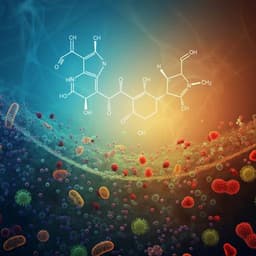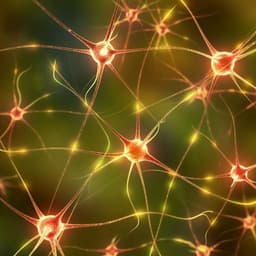
Medicine and Health
MDMA enhances empathy-like behaviors in mice via 5-HT release in the nucleus accumbens
B. Rein, K. Raymond, et al.
MDMA robustly enhances empathy-like behaviors in mice—boosting the social transfer of pain and analgesia via serotonin (5-HT) signaling in the nucleus accumbens; optogenetic 5-HT release reproduces these effects, and systemic MDMA or NAc 5-HT stimulation rescues empathy deficits in Shank3-deficient autism-model mice. Research conducted by Ben Rein, Kendall Raymond, Cali Boustani, Sabrena Tuy, Jie Zhang, Robyn St. Laurent, Matthew B. Pomrenze, Parnaz Boroon, Boris Heifets, Monique L. Smith, and Robert C. Malenka.
~3 min • Beginner • English
Introduction
The study investigates whether MDMA enhances empathy-like behaviors and identifies the underlying neural mechanisms. Empirical human studies on MDMA’s empathogenic effects have yielded mixed results, and mechanisms remain unclear. MDMA is of growing clinical interest as an adjunct to psychotherapy for PTSD, potentially by strengthening patient–therapist rapport where empathy is critical. Human assays often rely on static images and self-report, limiting detection of dynamic empathic processes. The authors previously developed mouse “social transfer” paradigms modeling empathy-like behaviors: bystanders acquire pain or analgesia after interacting with demonstrators experiencing inflammatory pain or morphine-induced analgesia. The current work tests MDMA’s effects on these paradigms and probes brain-region and transmitter-specific mechanisms, focusing on the nucleus accumbens (NAc) and serotonin (5-HT) signaling. Given empathy alterations in autism spectrum disorder and ongoing MDMA trials in ASD, the study also examines a Shank3-deficient mouse model.
Literature Review
Prior clinical and experimental literature on MDMA shows strong anecdotal prosocial and empathogenic reports, but controlled human studies often find modest or inconsistent effects on empathy using image-based and self-report measures. MDMA is advancing as a psychotherapy adjunct for PTSD after successful phase 3 trials, raising the importance of mechanistic understanding. In rodents, MDMA enhances social preference in the three-chamber test and NAc has been implicated in prosocial behaviors; intra-NAc MDMA can recapitulate prosocial effects. The authors’ earlier work established social transfer of pain and analgesia in mice and implicated anterior cingulate cortex inputs to NAc. Other studies highlight 5-HT’s role in prosociality and differences between MDMA and SSRIs regarding affective empathy. Literature also indicates sociability rescue in ASD models via enhancing 5-HT signaling, particularly within NAc.
Methodology
Animals and overall design: Male C57BL/6J mice (8–16 weeks) were used for main experiments; where indicated, female mice were tested for sex comparisons. Additional lines included TRAP2 (Fos2A-iCreER crossed with Ai14 TdTomato reporter) for activity-dependent labeling, SERT-Cre for targeting serotonergic neurons, and Shank3+/− mice (heterozygous deletion exons 4–22) to model ASD; Shank3+/− were crossed with SERT-Cre for optogenetics. Mice were group housed, on a 12 h light/dark cycle, and experiments were conducted during the light period.
Drugs and dosing: MDMA 7.5 mg/kg i.p.; methamphetamine (METH) 2 mg/kg i.p.; morphine (MOR) 10 mg/kg s.c.; meloxicam 10 mg/kg s.c.; 4-hydroxytamoxifen (4-OHT) 50 mg/kg i.p. All dissolved in 0.9% saline (SAL). For intra-NAc infusion, MDMA 0.5 µg/side in 500 nl per side at 350 nl/min via bilateral cannulae targeting NAc lateral core.
Behavioral paradigms:
- Social transfer of pain: Demonstrator (DEM) mice received 10 µl CFA in the left hind paw 1 h before interaction to induce inflammatory pain. Bystander (BY) mice received SAL or MDMA 15 min before a 10-min social interaction with a familiar CFA-DEM cage mate. Mechanical sensitivity (von Frey) was assessed at 0/1, 6, 24, 48 h after interaction (time points varied with 10-min vs 1-h interactions). For methamphetamine control, BY received METH or SAL before the 10-min interaction.
- Social transfer of analgesia: Both DEM and BY received CFA. DEM additionally received MOR (10 mg/kg s.c.) 15 min before a 10-min interaction. BY received SAL or MDMA 15 min prior. Controls included CFA-CON-BY paired with SAL-treated CFA-DEM. Mechanical thresholds were measured 1, 6, 24 h post-interaction.
- Shank3+/− assays: Using WT littermates as DEMs, Shank3+/− BY underwent 1-h interactions for both pain and analgesia transfer paradigms. BY were pretreated with SAL or MDMA.
NAc-specific manipulations:
- TRAP2 labeling: Fos-CreERT2/Ai14 mice were injected with 4-OHT and SAL or MDMA immediately before social transfer to label active neurons; brains processed one week later to quantify Fos-positive tdTomato cells in NAc and ACC.
- Intra-NAc MDMA: Bilateral cannulae implanted into NAc lateral core. SAL or MDMA was infused immediately before the 10-min interaction; von Frey thresholds measured 1, 6, 24, 48 h (pain transfer) and 1, 24 h (analgesia transfer).
Optogenetics:
- Viral delivery: In SERT-Cre (and SERT-Cre x Shank3+/−) mice, AAV-DJ-EF1-DIO-hChR2(H134R)-eYFP or AAV-DJ-EF1-DIO-eYFP was injected into dorsal raphe (DR). After 6 weeks, bilateral optical fibers targeted NAc lateral core.
- Stimulation parameters: 473 nm laser, 5 ms pulses at 20 Hz, 12–15 mW at fibers, delivered throughout the 10-min (WT) or 1-h (Shank3+/−) social interaction; no light during von Frey testing.
- Behavioral readouts: Social transfer of pain and analgesia under DR→NAc 5-HT terminal stimulation vs control YFP; real-time place preference assay to assess valence of stimulation; control tests to ensure stimulation did not directly alter von Frey thresholds.
Von Frey testing: Mice habituated to plexiglass enclosures on wire racks; up-down method with 0.01–2 g filaments on the left hind paw; thresholds reported as means ± SEM. Time points differed by paradigm: for 10-min interactions, 1, 6, 24, 48 h; for 1-h interactions, 0, 4, 24, 48 h.
Three-chamber social preference: Standard apparatus and automated tracking to confirm social deficits in Shank3+/− mice.
Surgery and histology: Stereotaxic coordinates for DR virus injections and NAc fibers/cannulae specified; postoperative care with meloxicam. Standard perfusion, immunostaining for GFP to verify viral expression and fiber placements; Keyence fluorescence imaging.
Fiber photometry (subset): AAV9-hSyn-GRAB-5HT3.6 sensor injected into NAc; signals recorded before and after systemic MDMA to compare 5-HT dynamics in males vs females.
Statistics: GraphPad Prism; one-way or two-way ANOVA with Tukey’s post hoc for multi-group designs; unpaired two-tailed t-tests for two-group comparisons (Mann–Whitney if non-normal); repeated measures ANOVAs compared groups to controls at each time; outliers removed by Grubb’s test (P < 0.05).
Key Findings
- Systemic MDMA enhances social transfer of pain in male mice: BY mice given MDMA (7.5 mg/kg i.p.) 15 min before a 10-min interaction with a CFA-DEM showed markedly reduced von Frey thresholds relative to saline controls at 0–24 h, with recovery by 48 h (significant by two-way ANOVA; Figs. 1B–D). MDMA alone did not alter thresholds.
- No effect in females despite similar NAc 5-HT dynamics: Female BY did not show MDMA enhancement of pain transfer, although fiber photometry indicated equivalent MDMA-evoked 5-HT increases in NAc in both sexes (fig. S1D–H).
- Psychostimulant control: Methamphetamine (2 mg/kg) did not enhance social transfer of pain compared with saline BY (two-way ANOVA; Fig. 1E), indicating MDMA’s effect is not a generic stimulant effect.
- MDMA enhances social transfer of analgesia: In CFA mice, BY treated with MDMA and paired with a CFA-MOR-DEM displayed higher mechanical thresholds (greater analgesia transfer) at 1 h and 6 h, but not 24 h, compared to saline BY (one-way ANOVA; Figs. 1G–I). A 10-min interaction was insufficient for saline BY to acquire analgesia transfer.
- NAc is sufficient for MDMA’s empathogenic effects: Local infusion of MDMA into NAc lateral core before the 10-min interaction enhanced social transfer of pain (lower thresholds at 1 h vs NAc-saline BY; one-/two-way ANOVA; Figs. 2C–E) and analgesia (higher thresholds at 1 h; Fig. 2G), with effects dissipating by 24 h (Fig. 2H). TRAP2 labeling showed more Fos-positive neurons in NAc core of MDMA-BY than SAL-BY after interacting with a CFA-DEM (unpaired t test; Fig. 2A), while ACC TRAP counts were similar.
- Optogenetic 5-HT release in NAc reproduces MDMA effects: DR→NAc 5-HT terminal stimulation during the social interaction enhanced social transfer of pain (reduced thresholds at 1 h and 6 h vs YFP controls; recovery by 24 h; Figs. 3C–E) and analgesia (higher thresholds at 1 h; Fig. 3G; not at 24 h; Fig. 3H). Stimulation did not directly change von Frey thresholds when delivered during testing and produced no real-time place preference/aversion (fig. S3D–E).
- Shank3+/− mice show empathy-like deficits rescued by MDMA and NAc 5-HT: Shank3+/− BY failed to exhibit social transfer of pain or analgesia after 1-h interactions with WT DEMs. Systemic MDMA restored both pain transfer (lower thresholds at 4 h vs Shank3 SAL; recovery by 48 h; Figs. 4E–G) and analgesia transfer (higher thresholds immediately after interaction vs SAL; Fig. 4I; not at 24 h; Fig. 4J). Optogenetic DR→NAc 5-HT stimulation during the 1-h interaction similarly enhanced pain transfer in Shank3+/− (lower thresholds vs light-off condition; Figs. 4M–N).
- Interaction time unaffected: MDMA did not increase social interaction time with CFA-DEM in WT or Shank3+/− conditions (figs. S1B, S4C).
- Statistical robustness: Across experiments, group differences reached significance by ANOVAs with Tukey post hoc and unpaired t tests (e.g., *P < 0.05, **P < 0.01, ***P < 0.0001 as indicated).
Discussion
The findings demonstrate that MDMA enhances empathy-like behaviors in mice, specifically the social transfer of pain and analgesia, addressing longstanding uncertainty from human studies that relied on static tasks and self-reports. Mechanistically, the NAc core is a key node: local MDMA infusion and selective optogenetic release of 5-HT at DR→NAc terminals reproduced systemic MDMA effects, implicating 5-HT signaling within NAc as central to MDMA’s empathogenic action. The time course differences between systemic and local/optogenetic manipulations likely reflect pharmacokinetic and pharmacodynamic factors. The study also reveals sex specificity, with effects evident in males but not females despite equivalent MDMA-evoked NAc 5-HT signals, paralleling some human data showing greater male sensitivity to MDMA’s empathy-related effects. Importantly, MDMA and NAc 5-HT stimulation rescued empathy-like deficits in Shank3+/− mice, suggesting that targeting 5-HT signaling in NAc can restore specific social-affective processes relevant to ASD. These results broaden the role of NAc 5-HT in prosocial motivation and state contagion and encourage development of receptor-specific interventions to modulate empathy-related circuits.
Conclusion
This study shows that MDMA enhances empathy-like behaviors in mice, increasing the social transfer of both pain and analgesia. The effects are mediated by 5-HT release in the nucleus accumbens core, as demonstrated by intra-NAc MDMA infusion and optogenetic DR→NAc 5-HT terminal stimulation. MDMA and targeted NAc 5-HT release also rescue empathy-like deficits in Shank3+/− mice, highlighting a mechanistic pathway relevant to ASD. These insights provide a neurobiological framework for MDMA’s empathogenic effects and identify NAc 5-HT signaling as a potential therapeutic target for disorders with empathy impairments. Future research should delineate downstream NAc circuit mechanisms, identify specific 5-HT receptor subtypes involved, investigate sex differences, and translate dynamic, interaction-based empathy assays to human studies.
Limitations
- Sex differences remain unexplained: MDMA enhanced empathy-like behaviors in males but not females, despite similar NAc 5-HT elevations after MDMA; mechanisms underlying this difference were not determined.
- Limited behavioral scope: The assays model specific empathy-like components (state contagion) rather than higher-order cognitive empathy; generalization to complex human empathy is uncertain.
- Pharmacokinetic/temporal differences: Systemic vs intra-NAc MDMA and optogenetic manipulations exhibited different time courses; contributions from MDMA effects on regions outside NAc cannot be fully excluded.
- Mechanistic specificity unresolved: The precise NAc microcircuit and receptor-level mechanisms by which 5-HT enhances social transfer were not identified.
- Species and task translation: Findings in mice using social transfer paradigms may not directly translate to human empathic processes measured with conventional tasks.
- Shank3+/− baseline 5-HT signaling in NAc was not measured; potential alterations in SERT or 5-HT dynamics in this model remain to be tested.
Related Publications
Explore these studies to deepen your understanding of the subject.







